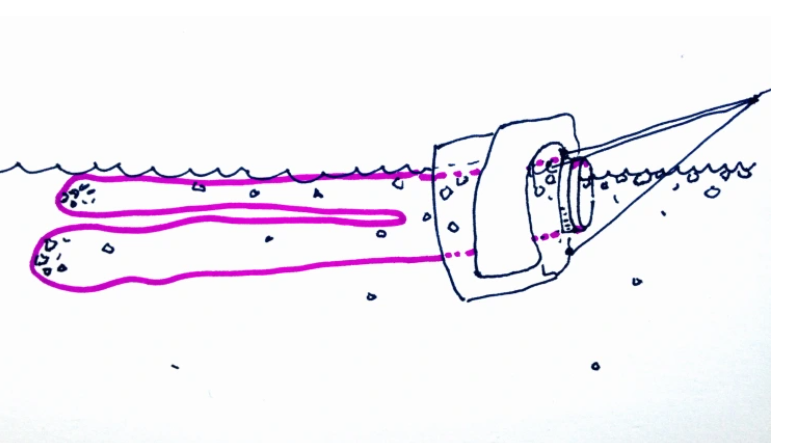 Després de l’exitosa conferència de l’Anna Sánchez adreçada a l’alumnat de batxillerat dels centres de la Xarxa d’escoles del parc natural de Cap de Creus sobre els microplàstics. Publiquem, la primera referència apareguda l’any 2015 al Canada sobre els BabyLegs. Un utensili casolà per recollir plàstics, de manera molt senzilla, que pot esdevenir un fantàstic recurs per treballar i conscienciar a l’alumnat de la importància de mantenir els oceans nets.
Després de l’exitosa conferència de l’Anna Sánchez adreçada a l’alumnat de batxillerat dels centres de la Xarxa d’escoles del parc natural de Cap de Creus sobre els microplàstics. Publiquem, la primera referència apareguda l’any 2015 al Canada sobre els BabyLegs. Un utensili casolà per recollir plàstics, de manera molt senzilla, que pot esdevenir un fantàstic recurs per treballar i conscienciar a l’alumnat de la importància de mantenir els oceans nets.
(Article en versió original)
Of the 5.25 trillion pieces of marine plastics in the world’s oceans, 92% are microplastics less that 5mm in size (Eirksen et al 2014), allowing them to be easily ingested by marine life as small as plankton (Cole et al 2013). Scientists are concerned that because plastics absorb up to a million times more chemicals than surrounding waters (Mato et al 2001), widespread ingestion means that toxicants that accumulate in animals can magnify up food webs, causing a potential threat to human health (Rochman et al 2013, Teuten et al 2009). This makes microplastics an environmental justice issue as people who eat marine mammals or who depend upon fish for sustenance are more likely to carry high toxic burdens.
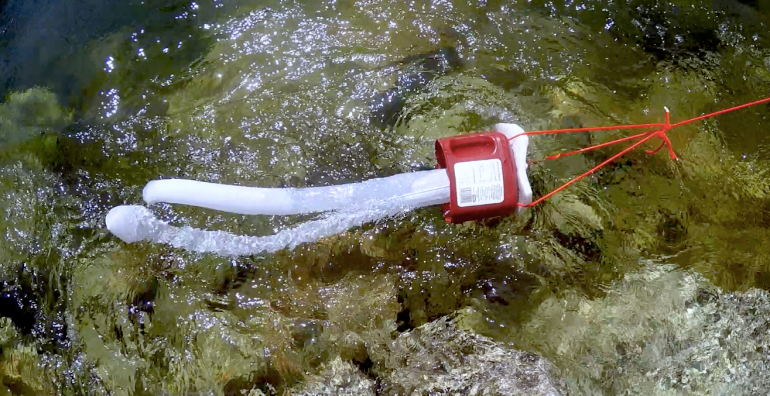
Created with baby’s tights, soda pop bottles, and other inexpensive and easy to find materials, Babylegs can be used to trawl for floating marine microplastics from a boat (motorized or hand-propelled). It is designed to mimic the type of samples collected by the more expensive Manta Trawl: floating microplastics less than 5mm in size. BabyLegs usually requires trawl times of 20 minutes to an hour, so is not appropriate for use by hand. If you do not have a boat and would like to check local waters for plastics, we recommend the Ice Cream Scoop, or a shoreline study.
BabyLegs is the most charismatic of our marine plastics monitoring technologies. The technology looks like a little person or jelly fish, and during presentations and field research, we treat the technology like a doll because it encourages people to approach us, talk to us, and share images of the technology. The goal of this technology is to make it as accessible as possible so people in remote northern communities can monitor plastics in their fishing and hunting areas.
Building Instructions. Materials
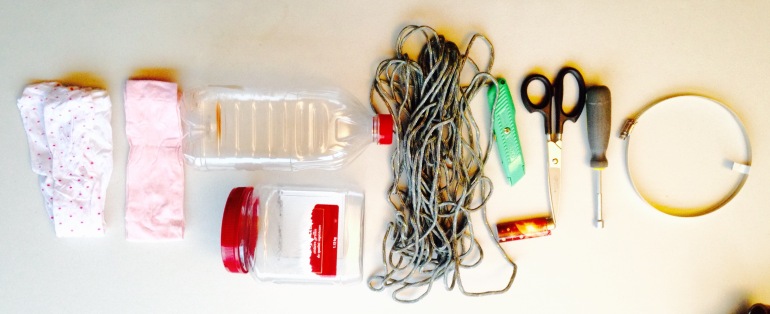
- waterproof container with a mouth at least 6 inches wide
- plumber’s clamp that will fit around the container
- nylon baby or toddler’s tights- we recommend pink or red incase fibres contaminate your sample, as it will be easy to pick out. Cotton tights will get too heavy to trawl when wet, so ensure tights are nylon.
- rope- we recommend a bright colour in case threads contaminate your sample
- scissors or utility knife
- screwdriver to open and close the plumber’s clamp
- drill or grommet punch (optional, but useful)
- file or sandpaper (optional, but useful)
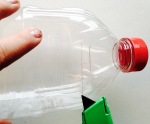 Step 1: Cut the bottom off a waterproof container to use as BabyLeg’s body. Ideally, there will be a place to crimp the plumber’s clamp later (see below). We recommend containers with openings 6 inches and larger to get adequate samples. Square-mouthed containers will give you a better idea of how much water passes through if you want to calculate the volume of water sampled, but if you are just sampling for the presence of plastics, a round-mouthed container will be fine. Any container will work. We’ve used bulk ketchup containers, kitty litter containers, small buckets, and even a cardboard milk carton. Use what works best in your environment based on what you have available.
Step 1: Cut the bottom off a waterproof container to use as BabyLeg’s body. Ideally, there will be a place to crimp the plumber’s clamp later (see below). We recommend containers with openings 6 inches and larger to get adequate samples. Square-mouthed containers will give you a better idea of how much water passes through if you want to calculate the volume of water sampled, but if you are just sampling for the presence of plastics, a round-mouthed container will be fine. Any container will work. We’ve used bulk ketchup containers, kitty litter containers, small buckets, and even a cardboard milk carton. Use what works best in your environment based on what you have available.
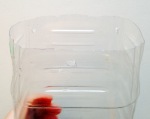 Step 2: Cut, punch, or drill three holes around the edges of the mouth of BabyLegs. The mouth should be the side with the smallest opening (otherwise it creates drag). Put holes above where you are going to put the tights. There should be two holes at the top and one at the bottom, as this configuration gives the trawler the most control over maneuvering BabyLegs with role while in the water.
Step 2: Cut, punch, or drill three holes around the edges of the mouth of BabyLegs. The mouth should be the side with the smallest opening (otherwise it creates drag). Put holes above where you are going to put the tights. There should be two holes at the top and one at the bottom, as this configuration gives the trawler the most control over maneuvering BabyLegs with role while in the water.
Step 3: Trim, file, or sand the holes so they don’t have sharp edges that might snag the tights. Do this for the cut edges at the top and bottom of the container as well. We don’t want runs in our tights–it’s bad for science because the snags might let samples escape.
 Step 4: Open a plumber’s clamp wide enough to put over BabyLeg’s body. If your clamp isn’t big enough, you can join two clamps together. Put the baby tights between the container and the clamp. The strongest part of the tights—the waist band—should be where the clamp attaches. You may have to crimp your clamp if your container is square (see image below).
Step 4: Open a plumber’s clamp wide enough to put over BabyLeg’s body. If your clamp isn’t big enough, you can join two clamps together. Put the baby tights between the container and the clamp. The strongest part of the tights—the waist band—should be where the clamp attaches. You may have to crimp your clamp if your container is square (see image below).
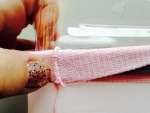
Step 4b: If possible, wind the tights around the clamp for added strength. If you clamp the thinner material, it may create holes.
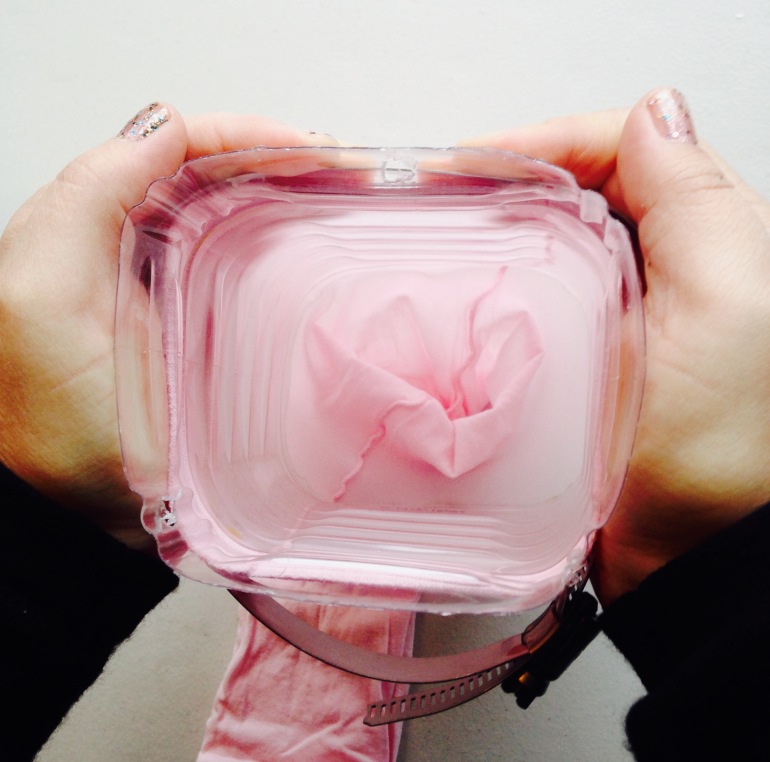
Step 5: Close the clamp security, but not too tightly that it stresses the container. If your container is square, you may have to keep crimping the corners so the clamp tightens evenly. Test by tugging on the tights.
 Step 6: Attach a rope to the three holes you’ve created around the mouth of the trawl. Tie them so that they evenly attach at one central point. If it is uneven, BabyLegs can spin in the water and snag up the lines. Melt or otherwise tie off ends of the rope so threads do not contaminate your sample. If you can’t melt them or are concerned that they might contaminate your sample, tie them so the ends are on the outside of the trawl rather than the inside.
Step 6: Attach a rope to the three holes you’ve created around the mouth of the trawl. Tie them so that they evenly attach at one central point. If it is uneven, BabyLegs can spin in the water and snag up the lines. Melt or otherwise tie off ends of the rope so threads do not contaminate your sample. If you can’t melt them or are concerned that they might contaminate your sample, tie them so the ends are on the outside of the trawl rather than the inside.
 Step 7: There are other additions to can add to BabyLegs depending on the type of water and vessel you are using. You can add “water wings,” soda pop bottle pontoons, manta wings, and other stabilization or flotation devices for very calm and slow water, or choppy water.
Step 7: There are other additions to can add to BabyLegs depending on the type of water and vessel you are using. You can add “water wings,” soda pop bottle pontoons, manta wings, and other stabilization or flotation devices for very calm and slow water, or choppy water.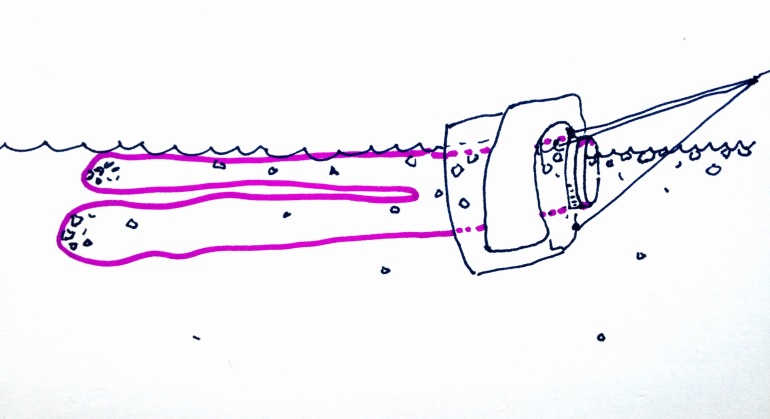
 |
 |
Step 1: Dropping the Trawl: Trawl out of the wake of your vessel, as wake down-wells plastics and you will get fewer in your trawl. You can use a side-mounted pole or other to keep BabyLegs away from the body of the vessel and out of the wake. We have found that BabyLegs (Ketchup Container version) can easily handle up to 5 knots of speed in semi-choppy waves for over an hour. The surface of the water should always be half-way on the mouth of the container so you catch things floating in the water.
Be sure to attach a “leash” to BabyLegs- an extra line that does not take any pressure and is tied to the boat directly. If your pole breaks or the main line malfunctions, you can use the leash to keep the device from being lost at sea, or being sucked under the boat.
Step 2: Removing the Sample: When you have trawled for a set amount of time (usually half an hour in lakes or longer in clear waters), pull BabyLegs up and let the water drain out of her toes. There are two methods for removing the accumulated sample:
a) If you have a hose: Leaving the clamped to the body, slowly turn the tights inside out, one leg at a time, and rinse everything captured into a sieve (if you don’t have a scientific sieve, you can use a fine mesh strainer used in kitchens– just remember that the larger the holes, the more microplastics you may miss). Repeat with the other leg. You can then transfer the items from the sieve into a jar.We usually bring tweezers and separate any plastics we find immediately, but you can also process the contents later. Add a cap full of hydrogen peroxide to the jar to keep the sample from smelling.
b) If you do not have a hose or a sieve, or if you are in a rush: Unclamp the tights, squeeze the water out, bundle the tights up, and put them in a sample bag or jar, and put on a new pair of tights in the field. You will then process the tights afterwards. You will need many spare pairs of tights for this method.Add a cap full of hydrogen peroxide to the jar/bag to keep the sample from smelling.
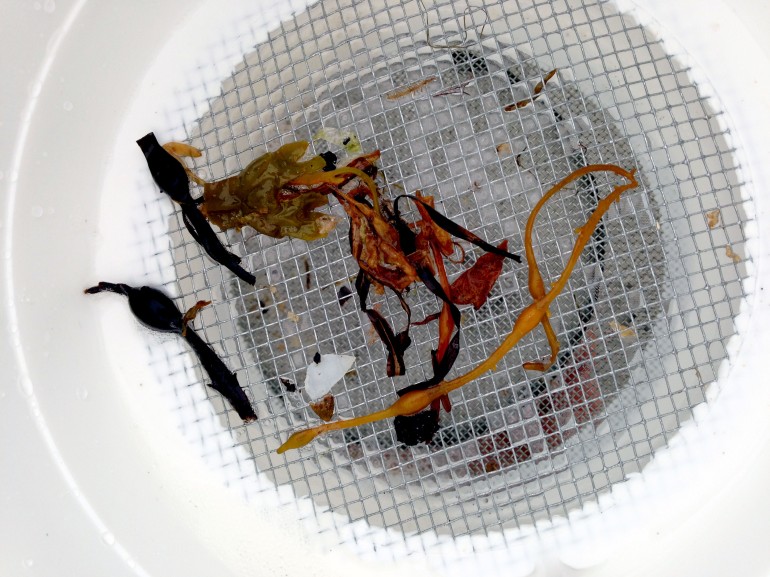
Step 3: Processing Samples: Once trawling is done, sort organic from inorganic material. We usually use tweezers and sort them into two petri dishes. This can be painstaking, especially in waters with a lot of organic material. You can also let samples dry first by putting them in paper coffee filters overnight.
The data gathered by BabyLegs is qualitative rather than quantitative, meaning that you can see whether there are plastics in an area, the types of plastics, and a general ratio of types of plastics to one another, but you cannot estimate the total amount of plastics in an area. This is because as BabyLegs picks up speed, the tights expand and the holes get bigger. When she slows down, the holes get smaller again. This means that some of the smallest microplastics have escaped, but some are still there. These amounts are not calculable. This means that you can have fun with BabyLegs and not worry if you make a mistake on a sample!
Have you built or used the LADI trawl? Please take our survey to help us keep improving!
 |
 |
 |
 |
![]() BabyLegs by Max Liboiron is licensed under a Creative Commons Attribution-NonCommercial-ShareAlike 4.0 International License. Permissions beyond the scope of this license may be available by contacting Dr. Liboiron at clearlab@mun.ca.
BabyLegs by Max Liboiron is licensed under a Creative Commons Attribution-NonCommercial-ShareAlike 4.0 International License. Permissions beyond the scope of this license may be available by contacting Dr. Liboiron at clearlab@mun.ca.
Works Cited
Cole, M., Lindeque, P., Fileman, E., Halsband, C., Goodhead, R., Moger, J. and Galloway, T.S. (2013), “Microplastic Ingestion by Zooplankton”, Environmental Science & Technology, 47(12):6646–6655.
Eriksen, M., Lebreton, L.C.M., Carson, H.S., Thiel, M., Moore, C.J., Borerro, J.C., Galgani, F., et al. (2014), “Plastic Pollution in the World’s Oceans: More than 5 Trillion Plastic Pieces Weighing over 250,000 Tons Afloat at Sea”, PLoS ONE, 9 (12).
Mato, Y., Isobe, T., Takada, H., Kanehiro, H., Ohtake, C. and Kaminuma, T. (2001), “Plastic Resin Pellets as a Transport Medium for Toxic Chemicals in the Marine Environment”, Enviro Sci & Technology, 35(2): 318–324.
Rochman, C.M., Hoh, E., Kurobe, T. and Teh, S.J. (2013), “Ingested plastic transfers hazardous chemicals to fish and induces hepatic stress”, Scientific Reports, Vol. 3.
Teuten, E.L., Saquing, J.M., Knappe, D.R.U., Barlaz, M.A., Jonsson, S., Björn, A., Rowland, S.J., et al. (2009), “Transport and release of chemicals from plastics to the environment and to wildlife”, Phil Trans Royal Society B: Biol Sci, 364(1526): 2027–2045.
